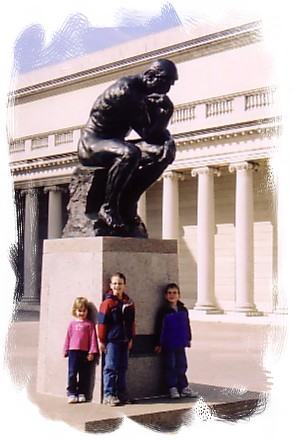As we entered the exhibit, we each picked up a magnifying lens from a basket to view the prints more closely. Some of the etchings were quite small yet intricately detailed. Of course handing children magnifying lenses led to my oft repeated refrain, "Don't bump them on the glass!"
 An aside: In 2004, I took Evan, Matthew and Sophie to the Legion of Honor Art Museum in San Francisco. I instructed the kids before we entered the museum about "Look. Don't Touch." but one of my children started out pointing to the paintings in his enthusiasm and accidentally touching the frames. A docent, watching us like a hawk, explained to us the problem with touching even the frame. The second time my son did it, I told him that we were going to have to leave if he couldn't control himself and the docent walked over and said the same thing. The message finally sank in and no more touching occurred on that visit. We spent a long time gazing at the paintings and the docent spent a long time gazing at us! After awhile, she walked over and complimented the children on their attention to the artwork, telling me that she had never seen kids look at the paintings so long. Her words made me feel a little better about bringing the kids to an art museum!
An aside: In 2004, I took Evan, Matthew and Sophie to the Legion of Honor Art Museum in San Francisco. I instructed the kids before we entered the museum about "Look. Don't Touch." but one of my children started out pointing to the paintings in his enthusiasm and accidentally touching the frames. A docent, watching us like a hawk, explained to us the problem with touching even the frame. The second time my son did it, I told him that we were going to have to leave if he couldn't control himself and the docent walked over and said the same thing. The message finally sank in and no more touching occurred on that visit. We spent a long time gazing at the paintings and the docent spent a long time gazing at us! After awhile, she walked over and complimented the children on their attention to the artwork, telling me that she had never seen kids look at the paintings so long. Her words made me feel a little better about bringing the kids to an art museum!I did not blog about this in 2004, because I still felt too embarrassed over the incident to want to dwell on it with words. :)
...and by the way, Young Boy Singing (Le Jeune Chanteur) was my favorite painting that we viewed at the Legion of Honor Art Museum.
Fast forward to this weekend's visit to the Rembrandt exhibit: Each time I heard the "click" of a magnifying glass bump against the glass of the frame, I half-expected a docent to come flying over to kick us out. The only warnings that occurred came from James and me, though. (I was very relieved that I never heard "Chink, crackle, tinkle, tinkle, tinkle.")
I have long admired Albrecht Durer's skill in carving such realistic portrayals of figures and settings and it was a privilege to see his work in person. However I gained a new appreciation of Rembrandt's work through this exhibit. It was far more impressive to see his prints in person than to look at them in a book. I marveled at his attention to detail, his masterful arrangement of figures, architecture, and landscape to highlight the drama of the subject, his portrayal of expression and emotion, and his expert contrasts between light and dark (chiaroscuro). The juxtaposition of his prints alongside the works of other artists emphasized for me why he is considered one of the greatest artists. His works had a depth and richness unmatched by others in the exhibit. As I walked from print to print, I inwardly cheered each time I came to a new Rembrandt.
One of my favorite etchings was The Flight into Egypt -- a night scene c. 1613 by Hendrik Goudt. (You can view it online here if you flip through this album by clicking in the corner.) I loved how the artist portrayed a night scene, the only light coming from the moon, the stars, a torch carried by Joseph, and a campfire, and the reflections from each.
The exhibition contained, for a few works, more than one print made from the original copperplate. It was striking to look at a print of Rembrandt's Descent from the Cross (flip through the online album, though the web doesn't come close to doing it justice), printed the year the copperplate was finished in 1633, in contrast to another printed 375 years later, showing the deterioration to the copperplate that occurred with repeated printings.
Dogs appeared numerous times throughout the works on exhibit, because the dog symbolized faithfulness. I had to laugh when I came to Rembrandt's Joseph Telling His Dreams (zoom in). Joseph's listeners look like they are listening with disbelief, or rolling their eyes, or muttering together. When I looked at the dog in the corner with my magnifying glass, I saw that it was licking its bottom in true dog-like fashion. Not even the dog could listen with respect!
Evan and Matthew were Latin sleuths as they went through the exhibit. They enjoyed looking for Latin words in the inscriptions almost as much as looking at the art itself.
As I strolled through the exhibit, I came to an etching by Jan George Van Vliet called Baptism of the Eunuch and stood looking at it, appalled at what I saw. The proportions of the horse were so distorted that they revolted at first glance. As I examined it further, I identified what bothered me about it. The ears were rounded, the whites of the eyes showed in human-fashion, the nostrils and lips protruded unnaturally, the legs were too short and stocky. I called Sophie over and asked her, "What do you think of this horse?"
She replied with what she thought was the correct response when looking at official artwork, "It is pretty."
"Really?" I queried. "Does that look like any horse that you have ever seen?"
A docent had followed Sophie over when I called her, and he asked me, "Isn't that what a horse looks like?"
I replied, "Horses don't have round ears and eyes like that. It looks like an Ape-Horse."
The docent quickly walked away, and I realized that I had probably expressed my opinion too freely and possibly crossed over into the realm of sacrilege as far as he was concerned.
But that horse was really offensive. It was like the artist had imagined some mythical African horse breed for his etching. He obviously had not studied equine anatomy!
The LDS church hosted the exhibit, and I gathered from viewing the introductory video that they considered it a worship experience, saying that the artists were inspired by the Holy Ghost in their works. I certainly praised and thanked God for the gifts that he bestowed on the artists and deeply appreciated their works, but I did not view the art as a means of worship in the way that the video described it. The artists' interpretations of biblical events did not add to my understanding of God's Word in scripture.
In this online album of the work of Hendrick Goltzius displayed in the exhibit, successive prints depict the Passion of Christ. I noticed that the face of Christ in each seemed to have a detached, pious, possibly slightly pained expression, even when He was portrayed as beaten or crucified. I'm not sure exactly what the artist was trying to communicate about Christ, but I thought he fell short in portraying the humanity of Christ and the depth of his suffering. However, no artist's interpretation can possibly fully convey the truth about Christ that is contained in the Scripture.
We spent two hours taking in this Rembrandt Exhibit and recommend it highly to any art enthusiasts!


4 comments:
wow. sounds impressive. your insights are most in depth and i found the detail of the dog in Joseph Shares His Dreams rather amusing...artists had humor too. thanks for sharing your experience.
Boy, those docents really do hover and snap at even the most minor infraction. However, I do understand the necessity.
I hope that your 2004 experience wasn't ruined over that, though. Any time I perceive that someone is annoyed with my kids, the whole experience usually becomes a wash in my eyes. :(
We need to get out more. Our Museum Musings would be very minimal indeed. Thanks for sharing about your visits!
Lee
What a fabulous exhibit to get to see. Thanks for sharing it! I'm a ways away from taking my children to see fine art. They're still so 'touchy' with everything and I spend too much time worrying about them. One of these days though.
Post a Comment